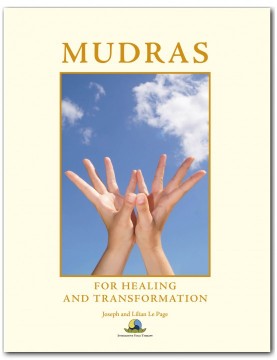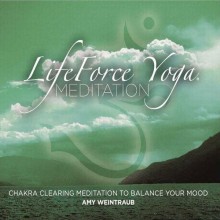
Joseph and Lilian Le Page have released their long-awaited mudra book, a labor of intense exploration and love, based on the traditions of Tantric and Hatha Yoga and their own deep practice. Mudras for Healing and Transformation is the culminating compendium of 108 hasta mudras (hand gestures), their specific health and spiritual benefits, their contradictions, and meditations and affirmations that put them to best use. The book will take its place as a classic in the yoga literature, as a resource for yoga students, therapists and educators interested in the therapeutic application of yoga. In fact, in this reader’s opinion, Yoga Mudras for Healing has the potential to change the face of the way most yoga is practiced in the West from its emphasis on what in India is referred to as “physical culture,” to a practice that has as its aim a fully realized life.
The book takes its clear organization from the kosha model, the five sheaths that define the dimensions of our human existence, from the physical body through the bliss body (the experience of our eternal and intimate true nature as divine). The authors investigate each kosha to discuss the systems by which we analyze and treat our imbalances. For example, in the Annamaya kosha dimension (physical dimension) there are nineteen mudras for specific health challenges, 6 to balance the five elements, and four for Ayurvedic healing.
The Le Pages made all the right choices in creating this book. Each section of chapters relating to its kosha begins with an illuminating introduction that combines historical reference, tradition and practice. Each mudra is given a two-page spread. The illustrations by Sergio Rezek and Carlos Eduardo Barbosa are stunningly beautiful and precise. The authors and illustrators have created a symbol system that gives quick access to the essential information. One look at the symbols on the first page of each mudra section tells you which of the twelve physical systems may be balanced, in which direction the mudra directs the energy (vayus), which chakra is likely to be balanced, and which Ayurvedic dosha is affected. There is a clear graphic that depicts on a scale of 0 to 10 the level of energy the mudra is meant to stimulate or calm. In equally clear prose, the Le Pages discuss the core quality of each mudra and where the hand gesture directs the breath in the body. In the interpretive text, the Le Page’s list the benefits and other mudras with similar effects. Practice instructions accompany the harmonious and detailed drawings. The second page of each mudra section offers a guided meditation that concludes with an affirmation invoking the mudra’s core quality.
Every element of this book is well-considered, including the appendices that illustrate mudras for the primary yoga postures, the principle pranayama and the most common mantras. Yoga therapist and physical therapist Matthew Taylor, PhD, ERYT-500, contributes an article suggesting directions that research may take in order to validate the effects that tradition assigns each mudra.
Mudras for Healing and Transformation is a book to keep by your yoga mat or cushion so that you can integrate and expand your practice of asana (postures), pranayama (breathing) and meditation practice with mudras. It’s a book to take on retreat to explore the deeper dimensions of your own spirit and awaken all aspects of your being. And finally, it’s a book to keep on your shelf as reference as you work with your own imbalances and health challenges and to share with those you serve. There are a few books I carry with me everywhere. Mudras for Healing and Transformation is now one of them. To order your copy of Mudras for Healing  and Transformation please click here.
and Transformation please click here.
For a LifeForce Yoga meditation practice for mood that includes mudras and mantras, click here.
“I have loved mudras since my first training. They have been very powerful in my work for health issues that have limited my more physical practice.” -Vicky L.